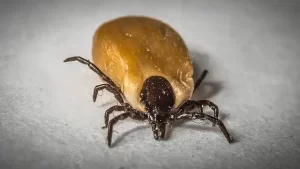Spinal Neuromodulation Quickly Restores Mobility in Completely Paralyzed People
- Engineered Soybeans with Pig Protein: A Promising Alternative or Pandora’s Dish?
- Severe Fever with Thrombocytopenia Syndrome (SFTS): A Tick-Borne Threat with High Mortality
- Why Isolating Bananas Extends Their Shelf Life?
- This common vitamin benefits the brain and prevents cognitive decline
- New report reveals Nestlé adding sugar to infant formula sold in poor countries
- Did Cloud Seeding Unleash a Deluge in Dubai?
Spinal Neuromodulation Quickly Restores Mobility in Completely Paralyzed People
- Red Yeast Rice Scare Grips Japan: Over 114 Hospitalized and 5 Deaths
- Long COVID Brain Fog: Blood-Brain Barrier Damage and Persistent Inflammation
- FDA has mandated a top-level black box warning for all marketed CAR-T therapies
- Can people with high blood pressure eat peanuts?
- What is the difference between dopamine and dobutamine?
- How long can the patient live after heart stent surgery?
Spinal Neuromodulation Quickly Restores Mobility in Completely Paralyzed People.
Nature Medicine | Saying goodbye to wheelchairs is not a dream! ‘Upgraded’ Spinal Neuromodulation Quickly Restores Mobility in Completely Paralyzed People.
Epidural electrical stimulation ( EES ) targeting the lumbosacral spinal cord can restore walking ability in patients with spinal cord injury ( SCI ) .
Studies have shown that with the assistance of multiple physical therapists, after months of intensive training, some patients with complete motor paralysis who receive treatment can even walk on the ground with EES, but the existing methods cannot be used in limited human resources.
Under the circumstances, the rapid recovery and flexible adjustment of exercise ability can be completed.
EES recruits afferent fibers at the entrance to the spinal cord via the dorsal roots, resulting in the activation of motor neurons embedded in the spinal cord segments innervated by the roots where these fibers reside.
Thus, targeting individual DRGs can modulate specific motor neurons. Based on this biological principle, the researchers developed an EES program that targets individual DRGs at predetermined times to reproduce the natural spatiotemporal activation patterns of motor neurons during walking.
Compared to previous continuous EES, this biomimetic stimulation procedure mediated better recovery of walking ability after SCI.
However, this technique involves paddle leads with electrode arrays targeting the dorsal column of the spinal cord and is designed to reduce pain, but recovery of motor function requires targeting of the dorsal roots, and the length of the existing paddle leads limits the number of dorsal roots that can be targeted by EES.
Therefore, a new technique needs to be devised to exploit the biological principles of EES recovery after SCI [1-5] .
On February 7, 2022, Grégoire Courtine ‘s team and Jocelyne Bloch ‘s team from the Swiss Federal Institute of Technology jointly published an article entitled Activity-dependent spinal cord neuromodulation rapidly restores trunk and leg motor functions after complete paralysis in the journal Nature Medicine.
The researchers designed and fabricated a paddle-like wire targeting the integral dorsal roots involved in leg and lower torso motion, established a computational framework combining high-resolution structural and functional imaging to optimize the positioning of this wire, and developed a Software to support rapid biomimetic stimulation procedures.
The researchers aimed to use this specially constructed combination of neurotechnologies to develop activity-dependent biomimetic stimulation programs to address severe motor deficits in individuals with SCI.

The sacrum (S1 and S2) , lumbar (L1-L5), and lower thoracic (T12) dorsal roots project to the spinal cord segments containing motor neurons innervating the muscles of the legs and lower trunk. To address the issues mentioned above, the researchers wanted to identify an electrode arrangement that could target all of these DRGs.
Previously, the researchers first determined the inter-individual variability in spinal cord anatomy using MRI and CT, with images showing remarkably consistent widths of the dorsal root entry zone across individuals.
The pulse generator can accommodate 16 electrodes, and the authors found that despite the different topology of the spinal cord, these electrodes can contact 16 targeted dorsal roots.
The authors created a pipeline for generating computational models of the interaction between the EES and spinal cord, and produced an atlas of 15 personalized computational models, providing resources for studying optimal electrode placement in large populations.
The researchers believe that determining the optimal arrangement of electrodes requires limiting the analysis to key features that determine EES selectivity, including:
1) the cranio-caudal distribution of the spinal cord, with electrodes evenly distributed along the cranio-caudal direction according to the optimal length of the pulp;
2) Confirmation of lateral position, with simulations showing that placing electrodes 4.7 mm from the midline would mitigate the effects of mediolateral bias;
3) Midline position for conducting current, simulations showing that using lateral and midline electrodes to create a multipolar configuration could direct current. towards the target root while minimizing the recruitment of the contralateral root;
4) the alignment of the sacral region, as coagulation of the lumbar root around the sacral segment hinders selective recruitment of the sacral root entry zone.
The researchers confirmed the arrangement of 16 electrodes based on these 4 features.
However, across the 15 computational models, the performance varied widely, due to a mismatch between the fixed arrangement of electrodes and the variability in spinal cord topology.
Therefore, precise preoperative planning to optimize electrode positioning is critical.

Figure 1. Optimal arrangement of electrodes based on 4 key features.
Next, the authors performed intraoperative CT scans to map the mounting location to each participant’s anatomy, administered EES and monitored muscle responses with electromyography.
This electrode arrangement enhances EES coverage and afferent fiber selectivity compared to the arrangement originally designed for pain relief.
Despite these advantages, achieving a biomimetic effect requires the delivery of synchronized stimulation waveforms that are switched on and off at precise times, as well as the adjustment of stimulation parameters in a wireless closed loop.
To this end, the researchers not only upgraded the Activa RC implantable pulse generator, which supports real-time updates of EES frequency, amplitude, and time from up to 10 stimulation waveforms, but also developed a touch-screen operating software that enables activity-related stimulation programs quick configuration.
Notably , this new technique enabled 3 participants who exhibited complete sensorimotor paralysis to walk independently on a treadmill on only the first day, compared to previous EES methods that required months of training to resume walking, although Poor gait.
After another 1-3 days, the gait was optimized and all 3 participants were able to walk independently on the ground with the support of a multidirectional body weight support system, and 2 of them could even adjust the range of leg movements.
The principle of restoring walking on EES seems to be generalizable to other exercise types as well.
The researchers configured activity-specific stimulation programs that enabled the three participants to use their legs to swim in water or actively pedal on an e-bike, and even do squats and leg presses.
After a 5-month-long rehabilitation program, all 3 participants gradually regained full weight-bearing capacity and were able to perform a 6-minute walk test without any assistance, and one even resumed climbing stairs and rough terrain ability to walk. These improvements all coincided with significant increases in leg and trunk muscle mass.

Figure 2. Participants regained mobility in addition to walking through different stimulation programs
In conclusion, this study demonstrates a powerful biomimetic EES technology that enables 3 fully paralyzed patients to regain multi-motor abilities within 1 day, and the computational framework provided in the study can be “tailored” optimally for different patients. Electrode and lead placement.
Overall, this therapy has important clinical implications for improving severely deficient exercise capacity in SCI patients.
Reference:
https://doi.org/10.1038/s41591-021-01663-5
Spinal Neuromodulation Quickly Restores Mobility in Completely Paralyzed People
(source:internet, reference only)
Disclaimer of medicaltrend.org
Important Note: The information provided is for informational purposes only and should not be considered as medical advice.



